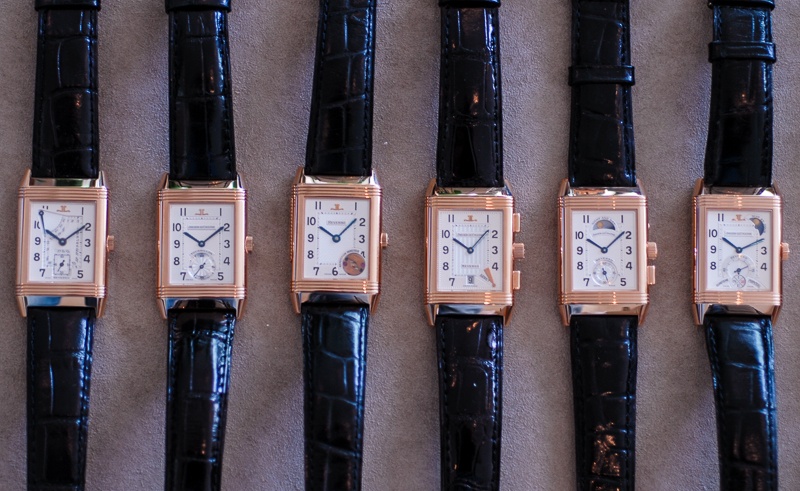
Ensuring the future - learning from the past: Jaeger LeCoultre’s re-ascent and the Reverso
219



[From left to right: the team of watches that brought complications back to the Manufacture: the 60eme, the tourbillon, the minute repeater, the chronograph, the GMT, and the perpetual calendar].
With Jaeger LeCoultre celebrating 180 years since foundation this year, and with another tour de force set of watches launched as part of that celebration, it is worthwhile taking a look back and recording how Jaeger LeCoultre came back from the brink; back from a time when only a few watchmakers were at the Manufacture producing only basic movements and ebauche. The last decade has seen a wealth of high complications from the Manufacture, from the Gyrotourbillon, to the innovative minute repeaters, the Hybris Mechanica, and the recent tour de force Reverso watches. It is almost as if we have come to expect such horological pyrotechnics from Jaeger LeCoultre, but the ability to produce such wonders has to come from somewhere. It just does not happen by magic (although granted, when looking at the watches, you might just think that).

[The Vallee de Joux from under the roof at Jaeger LeCoultre]
You cannot escape the past, and Jaeger’s past has set the foundations for what is now one of the most superlative, technical and innovative watch companies in existence. It is easy to believe now, with a certain assured calm that rests over the Manufacture Jaeger LeCoultre, that it has always been there. But only thirty or forty years ago, it was anything but. The quartz crisis was unwinding, and a few were helping the once great names come back to life. With some hard work, innovation, and a few laughs along the way, a dedicated group of individuals helped Jaeger LeCoultre rise from the ashes and reclaim its place as the watch manufacturer’s manufacture. Everything under one roof, and since that time, the roof has grown considerably: it is testimony to Jaeger Le Coultre’s continued success.
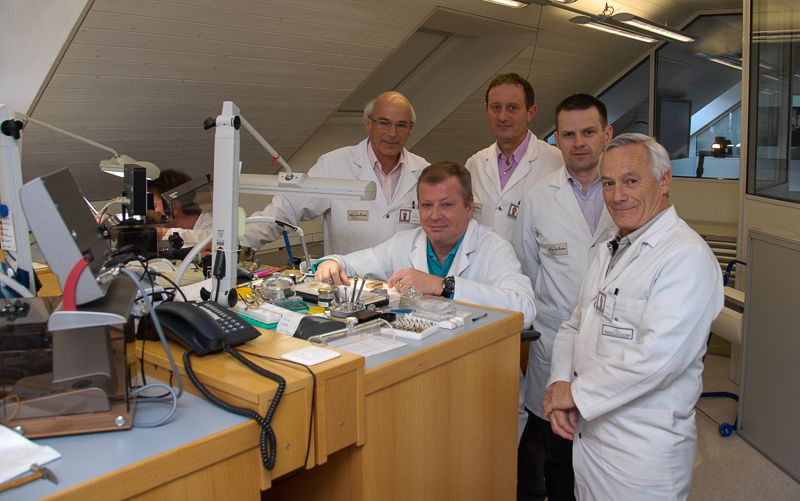
[The old guard from the original team: Joel Cordier, Joel Viot, Manel Guerin, Philippe Werhen, and Christian Laurent. Combined watchmaking experience at Jaeger LeCoultre: 166 years!]
Before it was too late, before the generation of individuals that had helped restore Jaeger LeCoultre to its (rightful) place at the top of the horological tree retired or moved elsewhere, I wanted to talk to the watchmakers, designers, and executives who were there, who are still at Jaeger LeCoultre, and form the foundation upon which complicated watchmaking is now built at the Manufacture. It was a chance to sit down, share a drink or two, and listen to some war stories from that time in the ‘tranches’ of Jaeger LeCoultre history. Throughout all the conversations at Jaeger over the two days I was there, the one element that everyone came back to was teamwork. It had been a joint effort, a collaboration, and the dedication had been throughout the development of the rose gold watches: working all hours and weekends to get the job completed. As well as the individuals concerned: the watchmakers, the watch designers, and the entrepreneurial spirit of Messrs Blumleim and Belmont, there was a series of watches, each one as a separate complication, each unique but part of a greater collective whole. It was the rose gold Reverso series that spanned the 1990’s and witnessed Jaeger LeCoultre’s ascent back to the heights of haute horology.
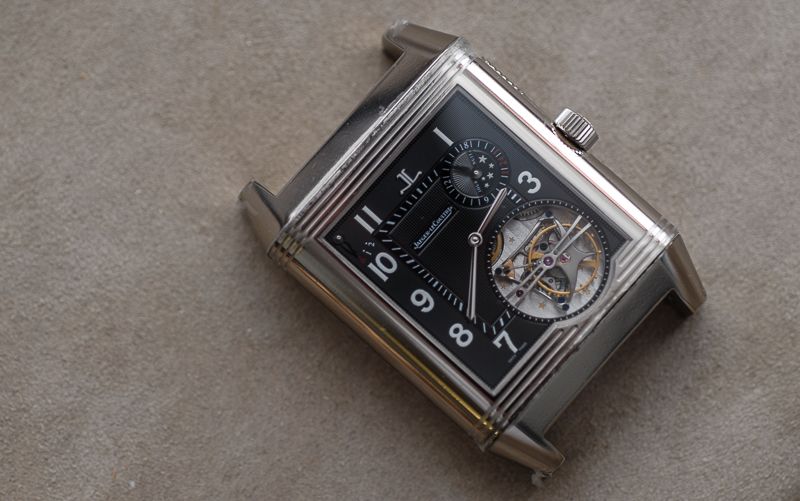
[A special edition 175th Anniversary Reverso. The perpetual calendar functions were derived from the rose gold Reverso (the last of the series).
In separating the complications into individual watches, the team of individuals (watchmakers, designers) could concentrate on that single complication and with it, all the nuances and elements that it had. While other watch firms were choosing to produce the single grande complication piece to celebrate their re-emergence into the haute horology world, Jaeger LeCoultre went about it in their own way. Each complication considered separately. There were six pieces in total for the rose gold Reverso series. It was planned that way. Each would have a specialist complication that would serve to both distinguish the individual watch, but also to allow watchmakers to learn about that individual complication. While there were individual watchmakers who would take the lead on a particular watch, this was a collective effort. Everyone was involved: learning how to construct, improve, complete. The rose gold Reverso series both brought the old designs and manufacture back to life, but allowed the designers, the engineers, and the watchmakers to learn and improve on the past. Now with the passage of time, to take what was learned then and innovate further to manufacture what we see today. Everything that is accomplished now is built upon the past, and without the rose gold Reverso series, that past might have been lost.

[The last in the rose gold Reverso series: a perpetual calendar that had the dials on both sides of the case. In terms of parts, the most complex movement of the series].
So where did it all start? We all know the basic facts of what happened: Jaeger was acquired by VDO (who set up LMH – Les Manufactures Horologes). Gunter Blumleim had been President of the Board at Jaeger LeCoultre since 1987; Jean Henri Belmont was the aide-de-camp who became Jaeger’s first CEO. But what of the individuals who made the watches, what were their recollections of that time?

[Sharing a few drinks, a few war stories, and a few laughs: from left to right: Sylvain Golay, Janek Deleskiewicz, and Stephane Belmont].
With the same debonair smile as it was in 1991, Janek Deleskiewicz relaxed into the seat and explained: “We planned the Reverso series because it was the only iconic watch we (JLC) had and that was known as a Jaeger LeCoultre”. The idea for the return of the Reverso owes much to an outside distributor: Giorgio Corro who at the time was the lead distributor for Jaeger LeCoultre in Italy and a Reverso fan. It was he who first suggested bringing back the iconic watch as a way of distinguishing the return of Jaeger LeCoultre’s watchmaking abilities. Other reasons were also apparent. Janek explained that we (JLC) didn’t have much money at the time, and if we wanted to economize on the marketing and advertising, then the particular style of the Reverso would stand out and you only had to promote the shape and overall design of the watch, rather than the necessary specifics of the watch.
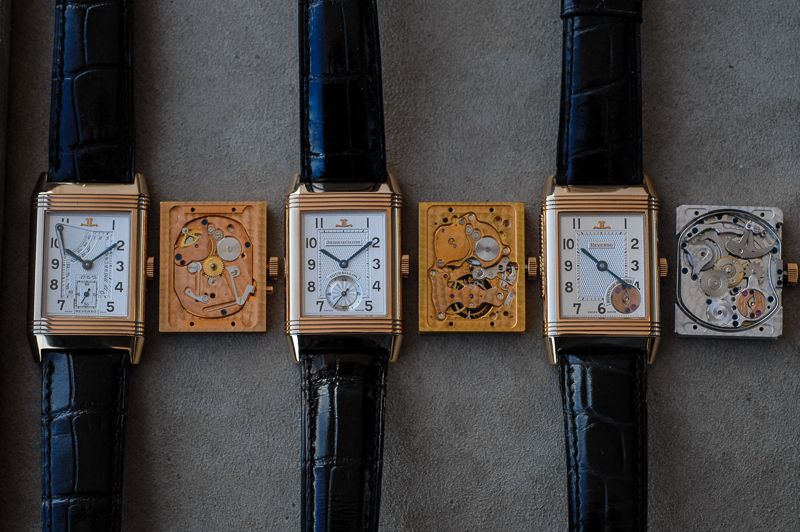
There were also parallels in history. It had not escaped notice that 1991 was the 60th anniversary of the creation of the first Reverso watch. The Reverso watch was responsible for both the creation of Jaeger LeCoultre as a firm, and the improved finances for the joint company. There was hope that the new Reverso series would do the same for the rebirth of the company. “You have to remember” Janek explained “that this was just after the quartz crisis and Jaeger was just about surviving”. Janek told me that there was an idea floated, shortly after he joined Jaeger, of simply closing the firm, buying back the brand name, and starting again. It never happened but, at the time, it was a considered possibility. To emphasize the point, Sylvain Golay turned to Janek, laughed, and asked if he remembered the time when the Manufacture even had to learn how to ‘blue’ the screws again! In re-learning the ‘bluing’ process, they almost burned down the roof!
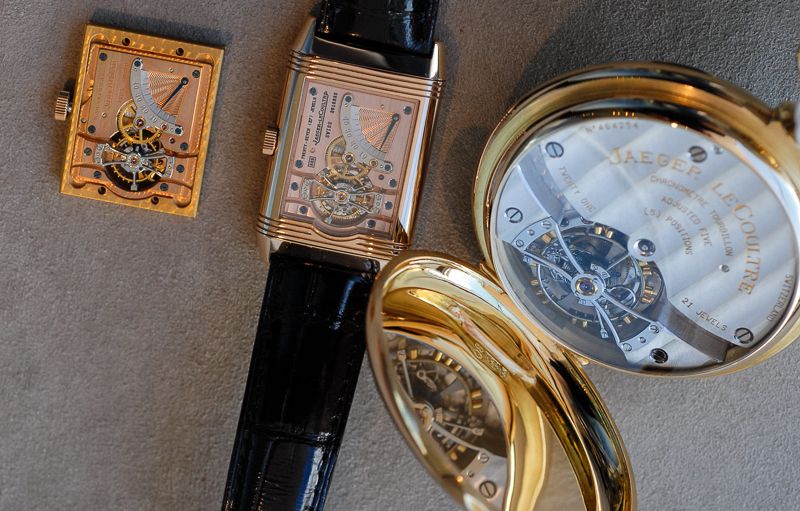
[Learning from the past: the Jaeger 828 movement to the left; the Jaeger 170 movement from 1948 to the right. The design of the 828 drew direct inspiration from the 170, including the escapement and gear train]
Janek is very much the same person now as he was 25 years ago when he was first starting off with Jaeger LeCoultre. As he has, for the past quarter of a century, Janek commutes from Paris to Le Sentier. His love of watches stemmed from his father who came back from a time in England during the war with a collection of watches. Janek, who had a background in artistic industrial design had spent some time in the car industry, as well as other mass consumption industries, his interest was industrial design where art and technology meet. Janek was given his chance in the watch industry by Jean Henri Belmont (Stephane’s father) and Gunter Blumleim. He was invited to the Vallee, and has been working there ever since. The senior figures may have moved on, but Janek is still there.

[Modern masterpieces such as the Gyrotourbillon 2 still keep design elements from the 828 and 170 movements.]
The designs for the movements and for the watch face for the rose gold Reversos, were both Janek in conversations with Sylvain Golay, Christian Laurent (among others) and Jean Henri Belmont, along with what he learned from the past designs and pieces in the basement of the Manufacture. A recurring argument was also that the old calibres, the old designs that were found in filing cabinets or in the ‘wall of calibres’, were both the inspiration for the new designs, and a way of learning about complex movements. For the design work, Janek admitted that the archives and old movements that could be found at the Manufacture were the source of inspiration and the guide to the design that would follow. He worked closely with the watchmakers, and the movement engineers to arrive at the final design. The new calibre’s (as they were for the rose gold Reverso series) were both an expression of the past as well as the future. The rose gold watches were intended to be manual wind as this was seen as a close interaction with the mechanical watch and the wearer (as the watches required winding daily) and separated the watches further from the quartz watch (which had no winding or ticking).

[Sylvain Golay at home in his small workshop where he continues to work on watches in his retirement.]
Sylvain Golay was the ‘wild card’ in the pack. Although he is now retired, he is still very much in contact with the Manufacture (Sylvain lives within sight of Jaeger LeCoultre). For the first two Reverso’s in the series, the 60eme and the Tourbillon, Golay was the master watchmaker in charge. Under his auspices the haute in haute horolergerie was returned at Jaeger. A native of the Vallee de Joux, Golay’s career (like others in Vallee at that time) was not initially in the watchmaking industry. He had trained as a telephone exchange engineer and was working at the local exchange, when under a change of heart he enrolled at the local technical college (watchmaking) just a short distance down the road from Jaeger LeCoultre in Le Sentier. Once Golay had graduated, work was found at a number of places including Dubois Depraz, then working on the Grande Complication at Blancpain during the early days of Jean Claude Biver’s tenure in charge. But it was a meeting between Sylvain Golay, Jean Henri Belmont, and Gunter Blumheim in 1989 that changed the course of his career and Jaeger LeCoultre for that matter.
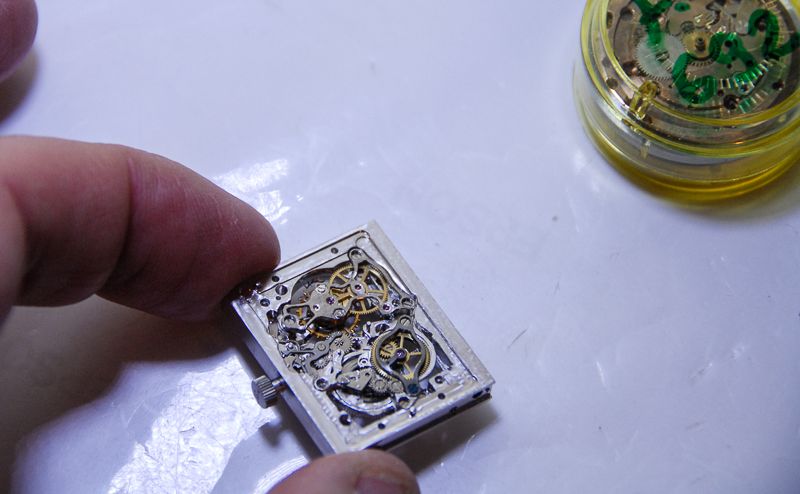
[One of the early skeleton versions of the Reverso tourbillons that Sylvain Golay developed].
As a watchmaker, Golay was the initial catalyst for change. He appreciated the freedom that was given to him by Blumheim and Belmont. Golay not only developed the first two watches of the rose gold Reverso series, but went on to provide the research work for the skeletonized Reverso Tourbillon and the 101. He worked on others in the rose gold Reverso series with the exception of the minute repeater. I wondered if there had been a purpose to the order of the watches, why the 60eme first, the tourbillon second, and so on until the sixth watch: the perpetual calendar. While the 60eme was planned as the first: a watch that would mark the beginning of the series with a movement that could then be used in other Reverso watches. The tourbillon was next because it was something that a quartz watch could not do! A quartz does not require a complicated escapement and the tourbillon remains a test of both a manufacture and a watchmaker. To show the movement, the escapement, and that the watchmakers art had returned to the Vallee.
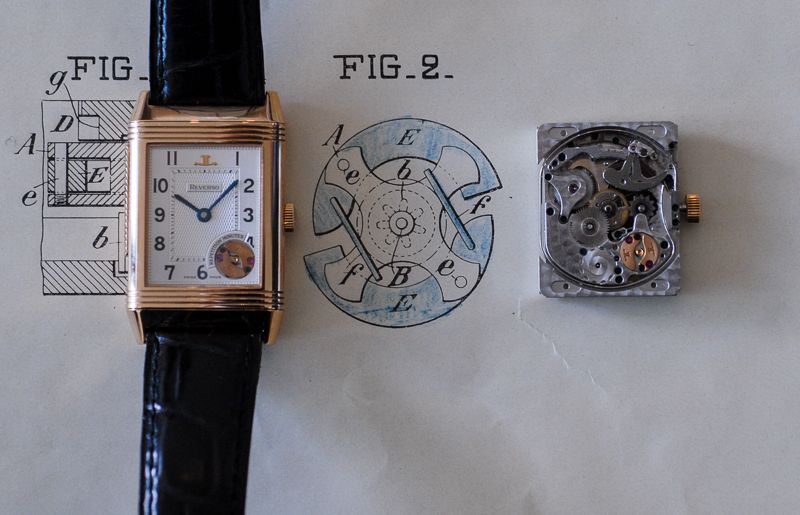
[The regulator for the hammers for the rose gold Reverso was developed and miniaturized from the 1904 patent held by Jaeger]
After the tourbillon, the minute repeater was the next high complication and required considerable research and development. The research and development for the minute repeater was put into a team of individuals led by Christian Laurent and Eric Coudray. As with the tourbillon the problem for the repeater was that it had to be developed from a blank piece of paper with only past designs and patents on repeater movements to guide the watchmakers. It was started at the beginning of the Reverso series (around 1990), but took years to develop into a workable watch.

[A repeater pocket watch from 1870; the rose gold Reverso from 1994; and the patent filing for the repeater mechanism from 1904]
The minute repeater rose gold Reverso had to overcome the size of the case, and yet have the repeating gong audible from some distance. The movement had to fit the dimensions of the case, and the gong had to follow the outline of the movement. The regulator, appearing in the dial for the Reverso as the movement is ‘back to front’, had to be miniaturized to fit the new movement size. The Manufacture could draw on its history of repeater movements and patents (filed over a century ago in 1904) to bring the gong, hammers, and regulator to life. The drawback, as Christian Laurent explained: to make the slide work required a case that was not water resistant. Since then, and for later repeaters, Christian Laurent solved the problem.
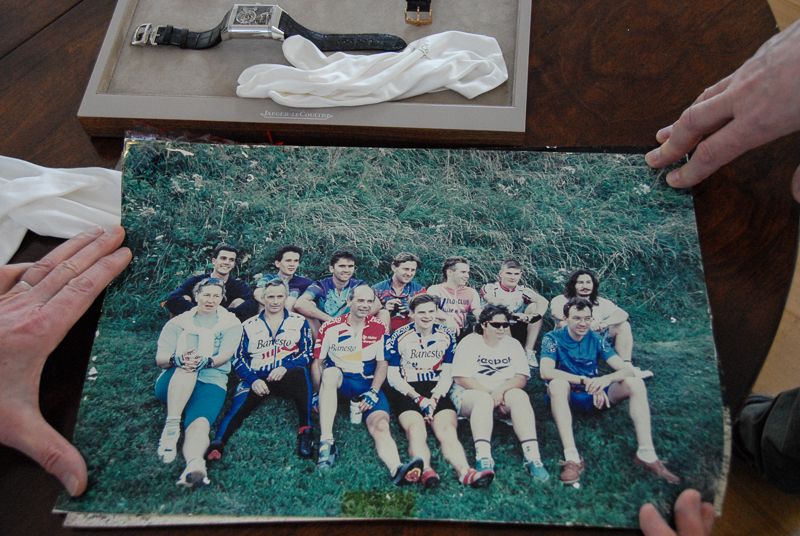
[The Sunday cycling gang! And the team working on the rose gold Reverso minute repeater]
Developing the repeater was a team effort, so much so, that competition found its way into the process. Christian Laurent explained every Sunday (weather permitting), the watchmakers of the complications room would cycle through the Vallee, whoever won, whoever managed to beat the rest, would be in charge of the complications room for the next week. It went on that way, a new lead, a new set of thoughts to follow, a new perspective, until the work was done. Christian Laurent still has some of the photos from the weekly cycling contest. He showed me the photo above: top right is Eric Coudray, front and centre is Christian Laurent, and others such as Joel Cordier can be found in the group. Christian Laurent worked on the regulators for the hammers to reduce friction and take out any vibration and noise. Christian smiled at the photo, looked up and said, I had to work extra hard each week to win, to stay in charge of the project. Although he was not always successful; win or lose in the cycling against the others, he said, the watches were always a team effort.
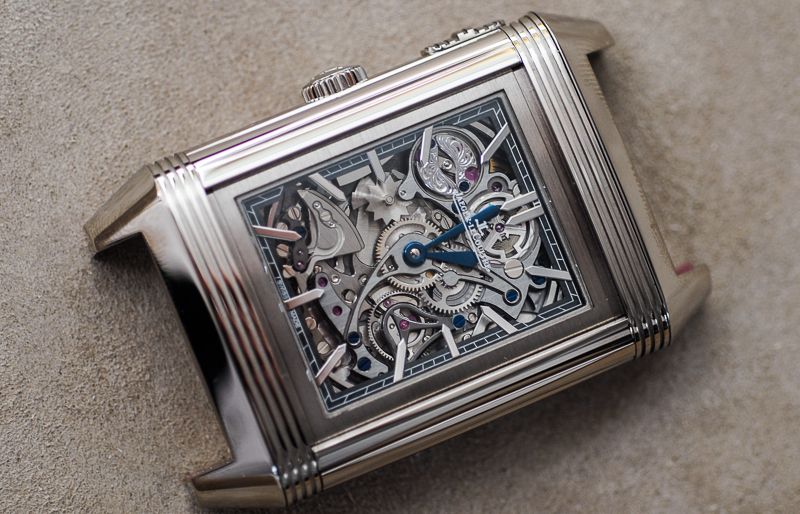
[The stunning 80th Anniversary Reverso minute repeater. Note in the top left hand corner of the movement the same design of regulator for the hammers.]
In the same way that when laid out in a row, with the movements beside them, the rose gold Reverso series appear as a team. This perhaps is no surprise as a “team” was how the watchmaking environment at Jaeger was described by each individual I talked to when describing working at the Manufacture. It was not one individual but a team of very talented individuals: the same way that the rose gold Reverso’s are a set of complicated pieces, who together make a harmonious whole. Alone, each piece is good enough; together they are an Opus, a symphony that continues long after the premiere has been played out.
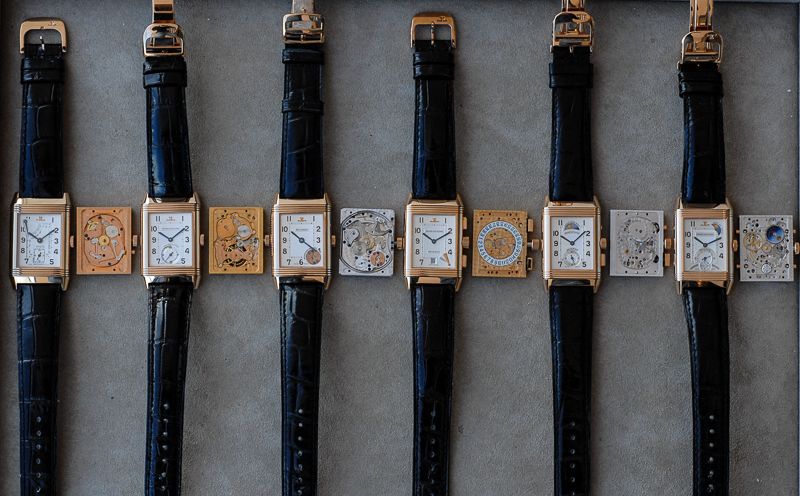
[A decade in the making: the rose gold Reverso watches and their movements]
The story of Jaeger LeCoultre’s revival, and continued success today, as most readers will have already surmised is not just about the watches, it’s about the people. The very talented and skilled individuals who comprise the Manufacture then, and continue to do so now, are the ones who create the watches at Jaeger LeCoultre. It is testimony to the camaraderie and work environment at Jaeger that so many individuals who were there in the early years (out of the abyss) are still there now. What was learned then, with each complication, has paid handsome dividends since, and will continue to do so into the future. Long after the current individuals have retired, the knowledge and the skills will have been passed on to the new generations. Jaeger LeCoultre’s strength now and in the future is possible because of its past.
Andrew H This message has been edited by 219 on 2013-05-12 14:56:17 This message has been edited by amanico on 2013-05-16 00:50:53
Comments:

Ruckdee May 12th, 2013-19:43
This is a beautiful read. Thank you so much for taking the time... ...to put the photographs, the facts and the anecdotes together. I admit to being pressed for time right now but will surely return to read this post again in details in a couple of days. Cheers to JLC! Ruckdee

219 May 13th, 2013-13:26
Thank Ruckdee. Appreciate you taking the time to read it. Although I will confess I enjoyed writing it! Thanks Andrew H

Sandgroper May 12th, 2013-20:48
Great article Andrew, wonderful reading and very.... instructive...interesting how "La Vie en Rose" started:):) Thank you very much, it makes me even more appreciative of La Grande Maison. Cheers, Francois

Ophiuchus May 12th, 2013-21:01
Just when I thought I had lost it... ..you brought back my love for Jaeger. The Reverso has always been a favorite of mine, and some collegues had turned me off them due to the courseness of their finishing in items such as the coates de geneve compared to other brands. I had lost some respe...

219 May 13th, 2013-13:30
Thanks and glad I could re-ignite to the passion for JLC. While we all like to see exemplary finish in terms of Cotes Geneve stripes, it is not the be all and end all. It certainly does not add directly to chronometric performance. I dont know on Sylvain Golay and the family name. I will say this: from ...
Greg D May 13th, 2013-00:08
Great piece Andrew - thanks Now must wind my Reverse Geographique...


Miranda May 13th, 2013-00:10
One of the best if not the best articles I've ever read… Thank you so much , it was a fantastic insight in the rebirth of JLC I had just started watch collecting when the 60ene was shown and I remember it well Thanks Imran

0-10-10
Load More Comments
Next Article
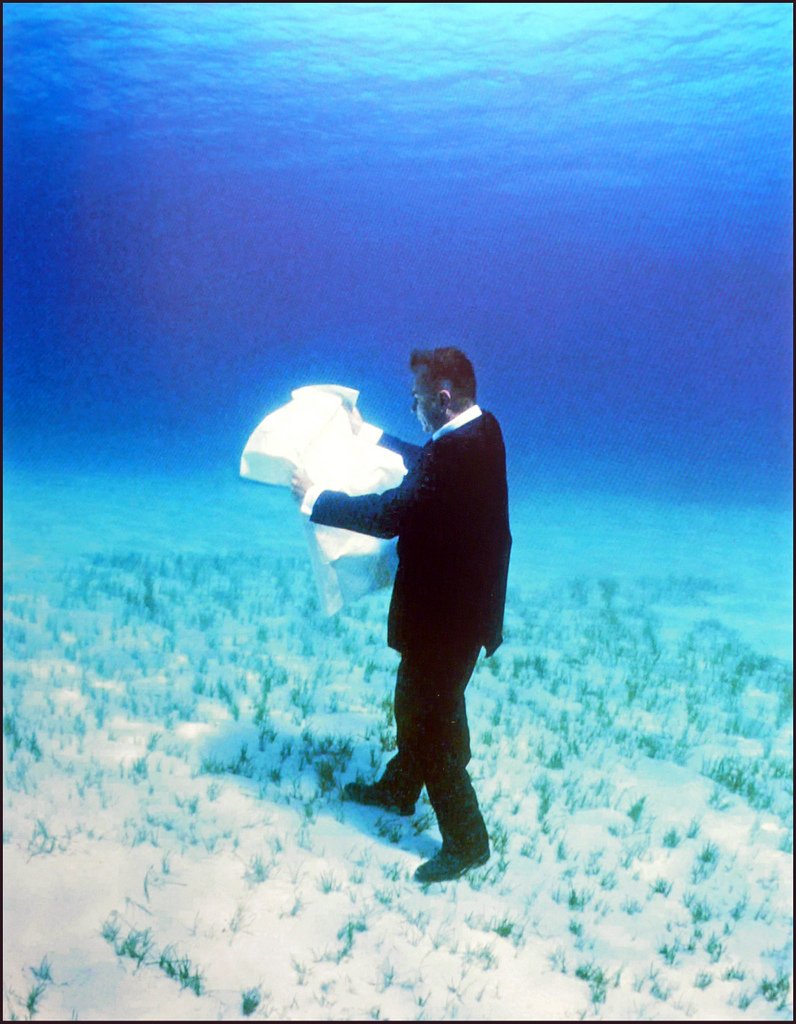
amanico


" Diving is Beautiful ", an in depth view on JLC Diving Watches and others.
amanico


Revisiting all the History of JLC Diving watches is a passionate Dive into the Beauty. Even if I'm a Polaris Lover, there is not only the Polaris to consider, as some other very interesting watches existed, before and after this Cult Watch. For those interested by the Polaris, I will brievely speak of it, here, as I did a Review you can read here: The main purpose of this post is to : 1/ Give some justice to these models which lived and still live in the shadow of the Polaris. 2/ To enhance the fact that ...
© 2017 - WatchProZine